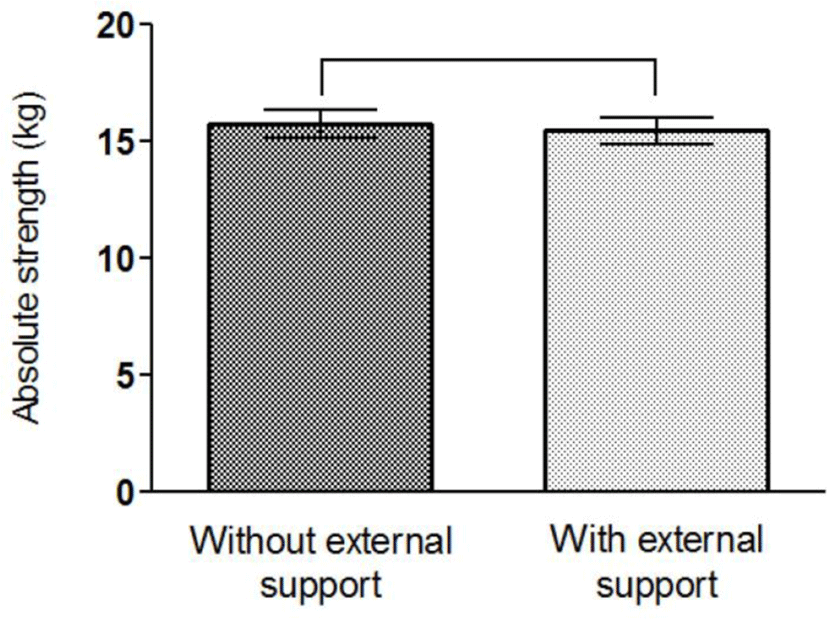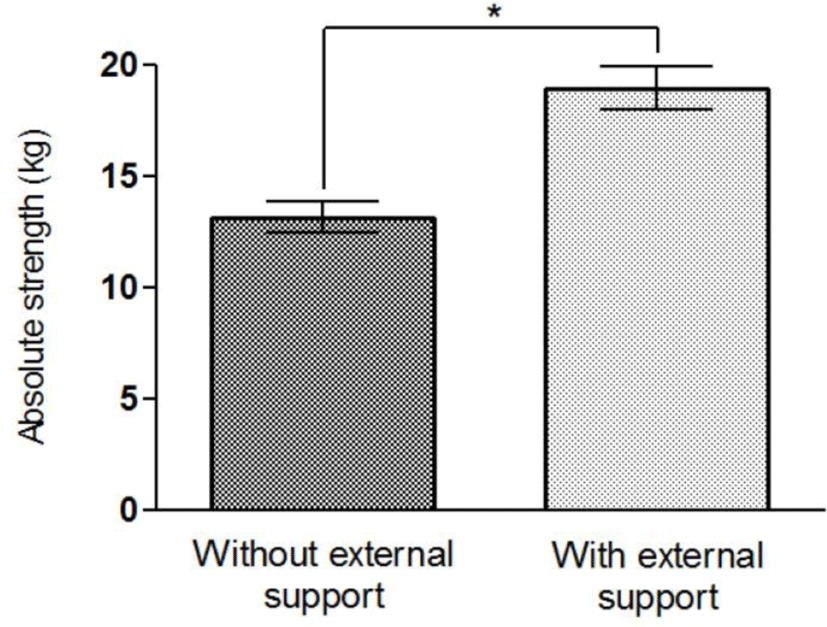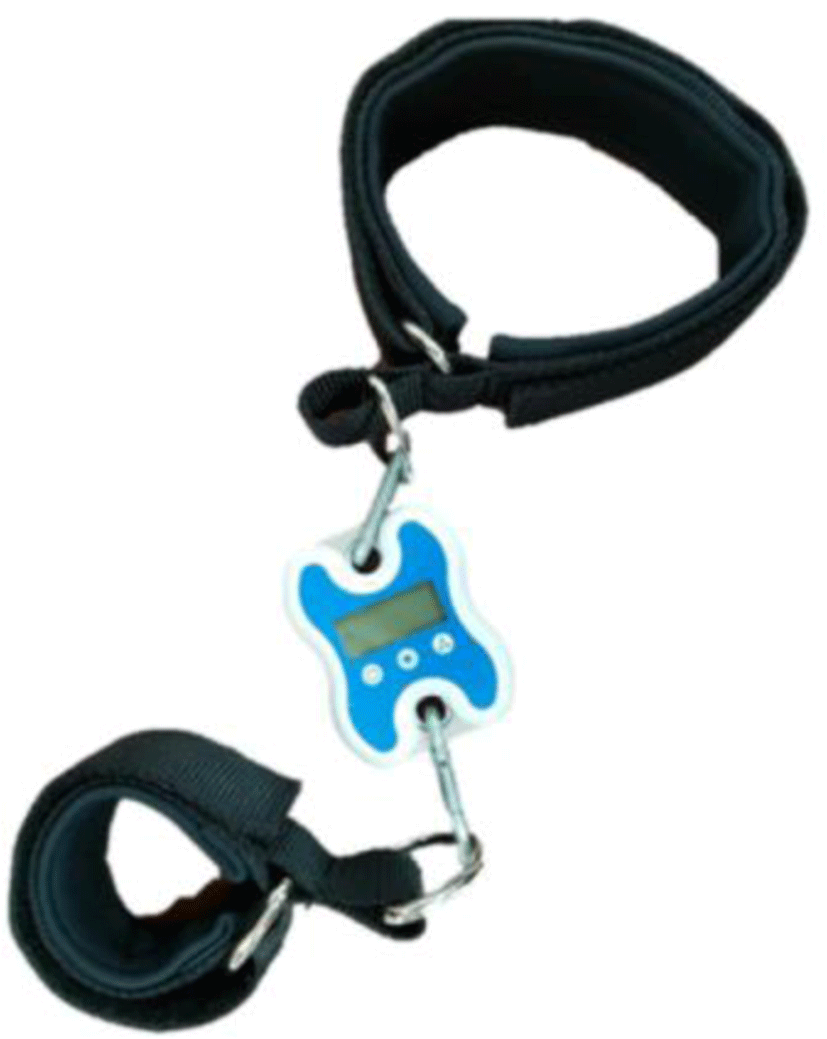INTRODUCTION
Core stability is defined as a stabilization provided by the isometric contraction of the lumbar and abdominal muscles.1 It has also been known as core strengthening and dynamic stabilization.2 Core stability contributed to the management of chronic lower back pain3, standing balance4, and musculoskeletal injury.5,6 Weakness of the hip abductor might result in lower extremity injuries and low back pain5,7 Previous findings reported that individuals with patellofemoral joint pain have weaker hip abductors, and external rotators, than the control group.8,9
Because hip abductors have a role of pelvic stabilizers, during a single-limb stance, they are considered as the important muscles surrounding the hip joint structures.10 Insufficient hip abductor muscles might result in a Trendelenburg gait11 or a Duchenne gait.12 Accurate evaluation of these compensatory mechanisms could be vital to objective assessment of hip abductor function.13 In case of the total joint arthroplasty, subjects were affected by hip abductor muscle deficits, such as weakness14 and functional limitations.15
Based on previous studies, the core stability have generally been evaluated with subjects in the supine16,17 and side-lying positions.4,18 No studies on hip abductor performance were investigated with the subjects in the standing position. Moreover, no study investigated the influence of core stability on the strength of the hip abductor in the standing position. Hip abduction in the standing position is the functional movement for testing the standing balance and performance of the gluteus medius.1,3 Investigating the role of core stability in standing is clinically helpful for prescription of the effective hip abductor strengthening exercise.
This study investigates the influence of core stability for testing hip abductor muscle performance in the standing position. Testing problems were reported with the strength improvement of the hip abductor muscles between the group with sufficient and insufficient core stability. Therefore, we hypothesized that in the group with insufficient core stability, the hip abductor strength in standing with external support would be significantly greater than the hip abduction without external support. In addition, no significant differences would be found in the hip abductor strength in the group with sufficient core stability, regardless of external support. Moreover, the intra-rater reliability would be greater in the group with insufficient core stability with external support than in the one without external support. The results of this study might contribute to the prefer treatment for testing hip abductor performance.
METHODS
G*Power software was used in a pilot study of five participants. The sample size was calculated with a power (0.80), an alpha level (0.05), and an effect size (1.48). The required sample size for the study was at least seven participants. Thirty-four healthy males (mean±SD; age=23.2±2.1 years; body mass=72.7±9.6 kg; height=174.8±4.8 cm) were recruited for this study (16 with insufficient core stability, 18 with sufficient core stability). The exclusion criteria were neuromuscular or musculoskeletal disorders, and pain in any body during tasks. The experimental protocols (No.1041849-201603-BM-015-01) were explained in detail to all subjects and they all provided written informed consent.
The unilateral maximal isometric strength of the gluteus medius muscle was quantified in standing positions to measure the hip abductor strength using the dominant leg.19,20 The strength measurement for the dominant side was performed as a tested hip side and the non-dominant side as the weight bearing side (contralateral side), between the groups with sufficient and insufficient core stability.
The double bent leg lowering test was used, as recommended by Comerford and Mottram21 to classify subjects with sufficient and insufficient core stability. A pressure biofeedback unit (PBU) was placed on the lumbar region. The subject was in a crook-lying position. The PBU was adjusted to 40 mmHg. The subject was asked to maintain the pressure at 40 mmHg±10 mmHg, without holding their breath during leg lowering. The subject was asked to maintain the pressure at 40 mmHg with hip joint flexed at 90 for 5 sec and with the heels placed just above the table for 5 sec. The subject was asked to dissociate the motion through the range of both hip extension from a 90 to a 45 degree hip flexion while the PBU pressure was maintained. Individuals who could maintain the PBU pressure below 10 mmHg were in the group with sufficient core stability. The group with insufficient core stability was defined as in a unstable pressure of the lumbar region that exceeded or decreased above 10 mmHg.21
The strength of the hip abductor muscles was measured by a Smart KEMA tensiometer sensor (Factorial Holdings Co., Ltd., Seoul, Korea) (Figure 1). The strap was positioned at 5 cm proximal to the lateral femoral condyle. A straight line was marked at the same region to minimize the regional difference.10 The length of strap was adjusted to hip abduction reaching 10 degrees in standing. The same procedure was repeated after 2 min of rest. The tensiometer was force-detecting system with measuring forces of up to 100 kg, 0.1 kg resolution and 0.1 kg accuracy. The height adjustable table was used as a conventional physical therapy treatment table fixed to the wall. The height of the table was customized to the ASIS height in each subject during the hip abduction, 10 degrees in standing.10 Before any measurement, the subjects performed with jogging for 5 min to prevent discomfort during each exercise.22
Each subject was familiarized with the hip abduction in standing both with sufficient and insufficient core stability, the examiner supervised all exercises. The hip abductor strength was measured for the dominant side in the standing position with sufficient and insufficient core stability and was randomized within each test session.
For the standing position, the subjects stood behind the height adjustable table, with the contralateral hip joint bearing the body weight. For the hip abduction in standing with insufficient core stability, the subjects were asked to abduct their hip joint without grasping the table; for the same performance with sufficient core stability, they were asked to grasp the table with the height adjusted at the height of their ASIS. During the measurements, the knees of both limbs were extended during the isometric maximal voluntary contraction with 10 degrees of hip abduction.8 The duration of this position was approximately 5 sec. The maximal strength (in kilograms) were retained by the tensiometer.
The data was normally distributed. The strength of the hip abductors was compared with two way mixed ANOVA between groups (with sufficient and insufficient core stability as a between factor) and with conditions (with and without external support as a within factor). Statistical significance was at α=0.05. If a significant interaction was occured between groups and an external support, the simple effects were used with the Bonferroni correction (α=0.0125). The Statistical Package for the Social Sciences for Windows, ver. 18.0 (SPSS, Chicago, IL, USA) was used for statistical analysis.
RESULT
In the group with insufficient core stability, the hip abductor strength in standing with external support was significantly greater than the hip abduction without external support (14.35±3.72 kg without external support, 20.14± 4.62 kg with external support; Changing values of strength 5.79 kg; F=–15.11, p<0.01) (Figure 2).

In the group with sufficient core stability, no statistically significant differences were found in the hip abductor strength regardless of the external support (16.37±2.53 kg without external support, 15.46±2.47 kg with external support; Changing values of strength 0.91 kg; F=1.66, p>0.05) (Figure 3). In addition, the hip abductor strength was signifiacantly differed between the groups with sufficient and insufficient core stability (p<0.01). The intra-rater reliability of the hip abductor strength measurement was greater in the group with sufficient core stability of 0.93 (95% CI, 0.82–0.97; SEM, 0.65 kg) than in the group with insufficient core stability of 0.80 (95% CI, 0.53–0.93; SEM, 1.32 kg). In the group with insufficient core stability, the intra-rater reliability of the hip abductor strength measurement with external support was greater than without external support of 0.97 (95% CI, 0.94–0.98; SEM, 0.55 kg).

DISCUSSION
Strengthening exercises for the hip abductor are important for weakness of hip muscles, especially for the chronic lower back pain and standing balance.5,7 However, most of the hip abductor strengthening was not commonly performed with consideration of the core stability. Moreover, a lack of consideration in the core stability may cause inappropriate exercise for the hip abductor muscles in individuals with insufficient core stability.3 The purpose of this study was to compare the influence of core stability to test hip abductor muscle strength in the standing. Based on the difference in the hip abductor strength according to core stability.
In this study, the strength of the hip abductor was measured in the standing position in groups with sufficient and insufficient core stability. The strength of the hip abductor was significantly greater with external support than without external support in the group with insufficient core stability. However, the strength of the hip abductor was not statistically different between the hip abduction with and without external support in the group with sufficient core stability. Greater strength of the hip abductor in the group with insufficient core stability was found especially with external support, which might imply that external fixation during hip abduction contributed to core stability and the strength of the hip abductor in standing. The intra-rater reliability of the hip abductor strength measurement was greater in the group with sufficient core stability than in the group with insufficient core stability. The intra-rater reliability of the hip abductor strength measurement in the group with insufficient core stability was significantly improved with external support.
The findings of our study indicated that in the group with insufficient core stability, the strength of the hip abductor was significantly greater with external support than without external support (44.1% strength difference in kg unit). Additionally, in the group with sufficient core stability, the strength of the hip abductor was not significantly different between hip abduction with and without external support (2.2% strength difference in kg unit).
There are potential reasons that may explain why the core stability led to the strength differences between with and without external support. First, this result can be related to biomechanical elements. The proximal stability with lower extremity exercise can be helpful to the activation of the gluteus medius and iliopsoas muscle attached to the spine and the pelvis.23,24 In addition, in a study by Cynn et al. also showed that the activity of the hip abductor increased significantly during side-lying with lumbar stability achieved using a PBU.18 The finding of our study was similar with the previous study indicating that the core stability can affected the hip abductor muscle performance. Although that study used the side-lying position to investigate the effect of core stability for selective hip abductor activation, hip abduction training with lumbar stability technique during side-lying can be recommended as a effective method of activating the hip abductor muscles.18 In this study, since the hip abduction in standing was initiated with both a hip and knee joint weight bearing position with external support, the external support might act to provide stability as a sufficient core stability contributing to greater strength of the hip abductor with external support than without external support. Second, this result may be explained by the length-tension relationship. Hip abductors are important muscles in the hip structures because they have a function as pelvic stabilizers, during a single-limb stance.10 In the standing position, the hip abductor on the weight bearing side acts to counter balance pelvis against the gravity. However, in the group with insufficient core stability, because of insufficient hip abductor as a pelvic stabilizer, the drop down of the contralateral side of the pelvis during hip abduction in standing resulted in a lengthened position of the hip abductor in the contralateral side, causing difficulty in co-contraction of both symmetric hip abductor muscles. Grasping the height adjustable table as an external support may provide external stability against gravity during hip abduction in standing. The external support might minimize the drop down of the pelvis on the tested side during hip abduction in standing, thus contributing to supporting the lengthened hip abductor muscle on the contralateral side.
This study had a few limitations. First, surface EMG was not used to investigate muscle activity during hip abduction in standing; nonetheless, functional tasks, such as standing hip abduction, recruit various muscles that connect the lower extremities and pelvis, since such activity is performed against gravity. Second, since healthy males were participated in this study, the findings of this study cann’t be generalized to females. Further study is nesessary to compare sex differences in changes in the hip abductor strength in standing. Finally, further study is nesessary to determine whether core stability training can improve gluteus muscle performance in standing.
CONCLUSIONS
In subjects with insufficient core stability, the hip abductor strength in standing with external support was significantly greater than the hip abduction without external support. The hip abductor strength in standing should be measured separately in conditions with and without external support. In addition, core stability training might be recommended to improve hip abductor strength in standing in individuals with insufficient core stability.








